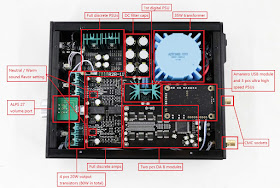This DAC has a tube-
like three-dimensional quality and clarity in the midrange. The layering of vocals and instruments in the sound field easily bested the other two even if it wasn't quite as wide as the Adcom. Very good extension at the frequency extremes, second only to the GDA600. Excellent in presenting micro dynamics (even better than the Adcom), there's no need to turn the volume up to high SPLs for excitement. However, at the louder side of the spectrum, the GDA600 has the upper hand in control and authority.
I listened to the R2R-11 in the neutral setting since the warm setting was too mushy in the context of my two set ups. Although I'm just an occasional headphone listener, I heard the same
tubey quality through my Grado SR80 headphones. With my
CS4398 DACs, I always found the coaxial input to sound superior to the USB. However, with this unit I could not detect a difference, so the Amanero USB input must be doing a good job!
This DAC reminded me very much of my
JLH 1969/Nobsound NS-02g Class A amp - a solid-state device that tries very hard to emulate a tube unit. Almost there, but not quite...
The DAC Wrap
After listening casually and intensively to these four DACs this past year, I realized that I want the virtues of all four devices without their vices - the dynamic presentation at louder levels of the GDA600 and the micro dynamics of the R2R-11, the transparency
and tube-
like quality of the R2R-11 (is it because of
NOS?🤔), the frequency extension and detail resolution of the GDA600, the wide sound field of the Adcom and depth of the Audio GD, the long-term listenability of the Audio Alchemy AND the affordability
of the Muse Mini TDA1543
x4. Can I have my cake and eat it, too?😊

















